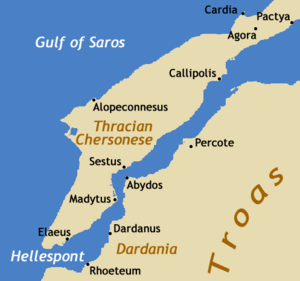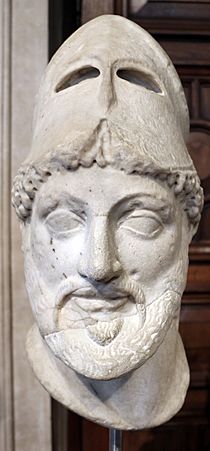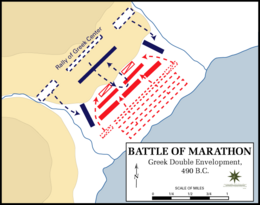Miltiades facts for kids
Quick facts for kids
Miltiades
|
|
|---|---|
| Μιλτιάδης | |
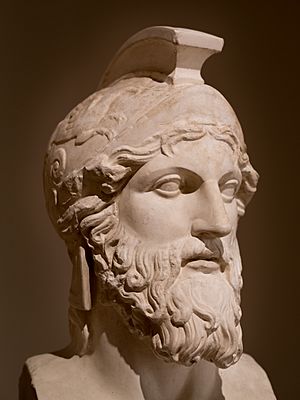
Roman copy of Greek bust of Miltiades (original dating to 5th−4th century BC)
|
|
| Eponymous archon of Athens | |
| In office 524 – 523 BC |
|
| Preceded by | Cleisthenes |
| Succeeded by | Calliades |
| Tyrant of Chersonese | |
| In office 516 – 492 BC |
|
| Preceded by | Stesagoras |
| Personal details | |
| Born | 550 BC Athens |
| Died | 489 BC (aged 60-61) Athens |
| Awards | Statue of Nemesis by Pheidias |
| Military service | |
| Allegiance | Athens |
| Rank | strategos |
| Battles/wars |
|
Miltiades (born around 550 BC, died 489 BC) was an important leader from Ancient Athens. He is best known for his clever military plans during the Battle of Marathon. This battle was a major victory for the Greeks against the powerful Persian Empire. Miltiades was the son of Cimon Coalemos, a famous Olympic chariot racer. His own son, Cimon, also became a well-known Athenian statesman.
Contents
Miltiades' Family and Background
Miltiades came from a respected family in Athens. His family was part of the Philaid clan. They were well-known partly because of their success in Olympic chariot racing.
Miltiades' father, Cimon, won three Olympic chariot races in a row. This made him very popular. Miltiades was named after his father's half-brother, Miltiades the Elder, who was also an Olympic chariot race winner.
Miltiades' son, Cimon, became a very important figure in Athens later on. His daughter, Elpinice, was also known for her discussions with another famous Athenian leader, Pericles.
Leader of the Thracian Chersonese
Around 555 BC, Miltiades the Elder left Athens to start a new settlement in a place called the Thracian Chersonese. This area is now known as the Gallipoli Peninsula. He became a semi-independent ruler, or tyrant, there, with Athens' support.
Miltiades the Younger, despite his family's past issues with Athens' rulers, rose in power. He became an important official in Athens in 524/23 BC.
When Miltiades the Elder died without children, his nephew, Stesagoras (Miltiades the Younger's brother), took over as ruler of the Chersonese. After Stesagoras died in 516 BC, Miltiades the Younger was sent to take control of his brother's lands. Stesagoras' rule had been difficult, with many conflicts. Miltiades wanted to have stronger control. He pretended to be sad about his brother's death. When important men from the Chersonese came to comfort him, he captured them. He then used 500 soldiers to make sure he had full power. He also made an agreement with King Olorus of Thrace by marrying his daughter, Hegesipyle.
Becoming a Persian Subject
Around 513 BC, Darius I, the king of Persia, brought a large army to the area. He forced the Thracian Chersonese to become part of the Persian Empire. This made Miltiades a vassal, meaning he ruled under Persian authority.
Miltiades joined Darius' expedition against the Scythians. He was left with other Greek officers to guard a bridge over the Danube River. Darius had used this bridge to cross into Scythia. Miltiades later said he tried to convince the other officers to destroy the bridge. This would have trapped Darius and his army. However, the others were too scared, and Darius was able to cross back.
Because of this plan, Miltiades' rule became risky. He had to escape around 511/510 BC. He later joined the Ionian Revolt in 499 BC, which was a rebellion against Persian rule. He returned to the Chersonese around 496 BC. He improved relations with Athens by capturing the islands of Lemnos and Imbros. He then gave these islands to Athens, which had old claims to them.
Returning to Athens
The Ionian Revolt ended in 494 BC. In 493 BC, Miltiades and his family sailed to Athens in five ships. They were escaping a Persian attack that followed the revolt.
The Athens Miltiades returned to was different. It was no longer ruled by a single leader. Fifteen years earlier, it had become a democracy, where citizens had a say in their government. Because of his past as a ruler in the Chersonese, Miltiades first faced a difficult welcome. However, Miltiades successfully presented himself as a defender of Greek freedom against Persian control. He also shared his knowledge of Persian tactics, which was very helpful since the Persians were planning to attack Athens. Because of this, Miltiades avoided punishment and was welcomed back. He advised the Athenians not to surrender to the Persian messengers who demanded tokens of submission.
The Battle of Marathon
Miltiades is often given credit for planning the winning strategy at the Battle of Marathon. In 490 BC, Miltiades was chosen as one of Athens' ten generals, called strategoi. There was also a 'war-ruler' called Callimachus. The ten generals were split evenly on whether to attack the Persians at Marathon or wait closer to Athens.
Miltiades had the most experience fighting the Persians. He strongly believed they should attack immediately. He argued that waiting would lead to Athens being destroyed. He convinced Callimachus to vote for a quick attack. He famously said, "I believe that, provided the Gods will give fair play and no favour, we are able to get the best of it in the engagement."
Miltiades also convinced the other generals to change their usual fighting methods. Normally, Greek soldiers called hoplites fought in a solid line called a phalanx, using shields and spears. Miltiades was worried about the Persian cavalry (soldiers on horseback) attacking the sides of the Greek army. So, he asked for more hoplites to be placed on the sides than in the middle. He ordered the two groups in the center to be four rows deep, while the groups on the sides were eight rows deep. Miltiades also had his men march close to the Persian archers, then run directly at the Persian army.
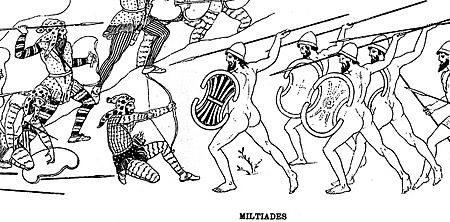
These tactics helped the Greeks defeat the Persians. After their defeat, the Persians tried to sail around Cape Sounion to attack Athens from the west. Miltiades quickly marched his men overnight to the western side of Attica. They blocked the two exits from the plain of Marathon, stopping the Persians from moving inland. The Persian commander, Datis, fled when he saw the same Greek soldiers who had defeated him the night before.
One idea about why the Greeks won is that the Persian cavalry was not there during the battle. This theory suggests the Persian cavalry left Marathon for some reason, and the Greeks attacked when they saw this.
Expedition to Paros
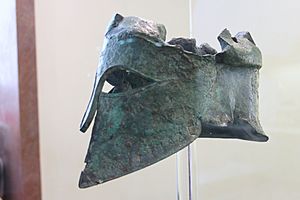
The next year, in 489 BC, Miltiades led an Athenian fleet of seventy ships. They went to attack Greek islands that had supported the Persians. However, this expedition was not successful. Miltiades specifically wanted to attack Paros, feeling they had disrespected him in the past. The fleet attacked the island, which the Persians had conquered, but they could not capture it.
During this campaign, Miltiades suffered a serious leg injury and became unable to fight. His failure caused an uproar when he returned to Athens. His political rivals used this opportunity against him. He was accused of treason and sentenced to death. However, his sentence was changed to a large fine of fifty talents. He was sent to prison, where he died from his wound. His son, Cimon, later paid off the debt.
Miltiades' Statue and Painting
Later, a famous sculptor named Pheidias created a statue in Miltiades' honor. It was placed in the temple of the goddess Nemesis at Rhamnus. Nemesis was the goddess who brought bad luck to those who had too much good fortune. It was said the statue was made from marble that Datis had brought for a monument to celebrate the Persians' expected victory.
A writer named Aeschines wrote that Miltiades wanted his name written in a famous painted porch in Athens called the Stoa Poikile. However, the Athenians refused. Instead of writing his name, they had him painted in the front row of the battle scene, shown encouraging the soldiers.
See also
 In Spanish: Milcíades el Joven para niños
In Spanish: Milcíades el Joven para niños
- Mētiokhos kai Parthenopē
Images for kids


